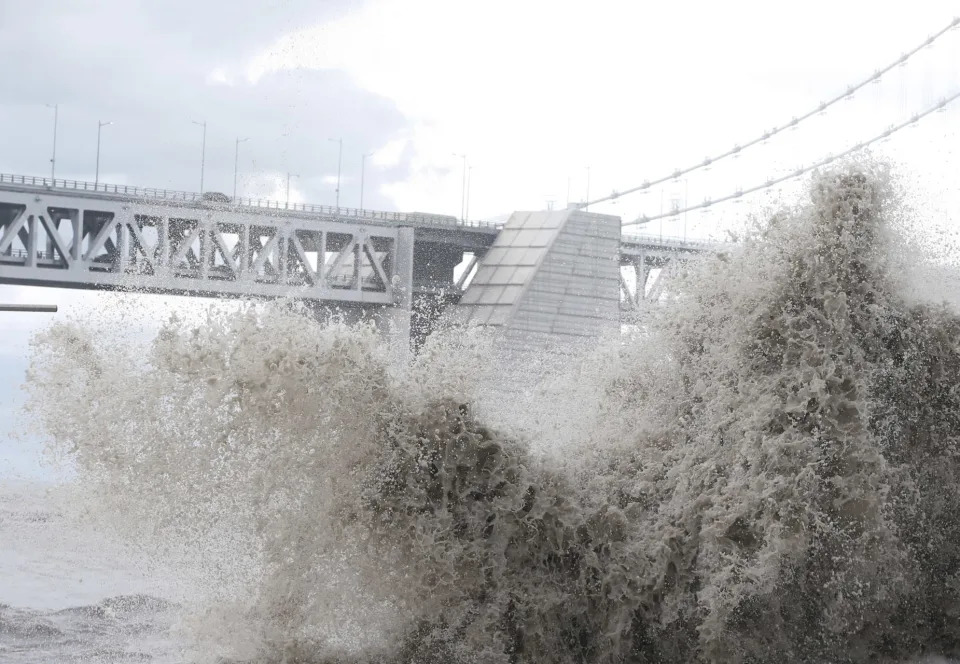Typhoon Hinnamnor, the strongest to ever hit South Korea, has left at least two dead and 10 missing in its path through the Asian country, in addition to thousands of evacuees, tens of thousands of homes without electricity and significant flooding in the eastern and southwestern fringe.
Hinnamnor made landfall today near Geoje Island, southwest of the city of Busan, the country’s second largest city, several hours earlier than expected, at around 4:50 a.m. local time (7:50 p.m. GMT Monday), according to the Administration. Korea Meteorology (KMA).
The storm, which carried winds of more than 140 kilometers per hour, returned to the sea after passing over the coastal city of Ulsan, 307 kilometers southeast of Seoul, just over two hours later.

Typhoon Hinnamnor
Busan and Ulsan were counted, together with the town of Pohang (270 kilometers southeast of Seoul) and nearby Gyeongju, among the places most affected by the gales, and especially by the volume of rain that has fallen.
In Pohang seven people are missing after entering the underground car park of a block of flats that was being flooded early today with the intention of moving their vehicles.
Another 66-year-old woman is also missing after going down to another parking lot in a residential complex, as is a 25-year-old man who fell into a pipeline during the early hours of Ulsan.
The two fatalities left by the typhoon so far are a 75-year-old woman who was swept away by the water when she was being evacuated in Ulsan and another 66-year-old who perished after a landslide destroyed her home in Gyeongju. .
MORE THAN 66,000 HOUSEHOLDS WITHOUT LIGHT
Around 3,000 people have been evacuated due to the danger of flooding and landslides in the provinces of South Jeolla (southwest), South Gyeongsang and Busan (southeast) and more than 66,000 households have suffered power cuts or still suffer.
Coinciding with the passage of the typhoon along the southeast coast, a fire was also reported at a Posco steel plant in the city of Pohang, 270 kilometers southeast of Seoul, although the company has not yet been able to confirm whether the incident was caused. For the storm.
Hinnamnor has also left images of supermarkets, streets or parking lots – both underground and outdoors – completely flooded in Pohang, and of significant damage to the Busan promenades, where areas near the sea have also been flooded.
This again underscores the infrastructure challenges facing the country after rains in August inundated entire neighborhoods in central Seoul, killing 16 people, at a time when extreme weather events appear to be on the rise due to climate change. .
The strong winds and two days of intense rainfall that the storm has brought in turn affected 122 ferry and ferry routes and forced the cancellation of 251 flights at 12 different South Korean airports.
TRAINS AND ROADS AFFECTED
Ground transportation has also been affected, with 354 trains canceled or delayed and several roads and highways across the country partially closed, including the Seoul Olympic Highway, one of the capital’s main arteries that runs along the south bank of the Han river.
While rain alerts still persist on the eastern coast, the KMA forecasts that Hinnamnor will continue to move northeast through the Sea of Japan (called the East Sea in the two Koreas) after having passed, still with a “strong” typhoon category, a hundred kilometers east of the South Korean island of Ulleung.
It is expected that by 9:00 p.m. (9:00 GMT), and already weakened, it will be found off the coast of the eastern Russian province of Primorye – some 360 kilometers east of the city of Vladivostok – and the northern Japanese island of Hokkaido.
In North Korea, where the effect of the typhoon has predictably been less, leader Kim Jong-un chaired a meeting the day before to advise on preparations for the arrival of abundant rains caused by the front that drags Hinnamnor and that can suppose a problem for the agricultural sector of the impoverished country.

